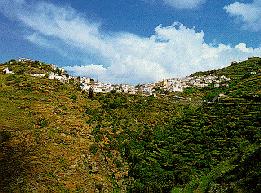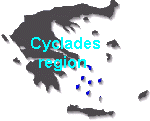| KEA |
 |
 |
This description provides information of ancient sites, seaside resorts, churches, monasteries, landscapes and small towns and villages. Additional details can be found in various books printed on Greece, such as the 'Blue Guide to Greece.' The names of places conform to the accented Greek pronounciation which would be the one a traveller would face upon a potential visit.
For a general map of the Kyklades, click here!(55K).
To go back to the Kyklades main page, click here!
Kéa is the island of choice for vacationing Athenians. Dont expect to meet many foreigners; there are very few, most of the preferring to visit other islands.
Also called Tziá, the island has an area of about 121 square kilometers and contains 86 kilometers of beaches. It is connected from Lavrion and Piraeus with a ferry (it is only 12 miles from Lavrion - 1 hour by ferryboat). The inhabitants live in two communities, Kéa and Koríssia.
Kéa was inhabited by Pelasgic peoples followed by Káres and Phoenecians. Kéans become friends of Erétrians, until the latter were destroyed by the Persians. Kéans took part in many naval battles including the one against Persians with their own ships.
The style of the island today in mostly Cycladic but has kept some differences including the style of houses, using tiled roofs instead of the mainly cycladic white washed tower tops. It also has more than 200 churches, some of which, such as Agía Anna, Episkopí and Agio Panteleímon are Byzantian monuments.
Transport: You can visit Kéa from Lávrio, where the trip takes 1h30m, four crossing per day (info: 0292/25249). From Kéa you can visit Kythnos, twice a week (info: 0288/31344).
VOURKARI
This is a small town, full of taverns offering fresh fish. Nearby, during excavations that were done in 1960-1962, were found ruins of temples, houses and pottery. A small silver lion was also found, all of them indicating that the island was occupied around 2000 BC.
PANAGIA KASTRIANI
This Monastery, situated in the East of the island, has 30 beds for rent(check for availability). It was built during the 18th century ontop a precipitous cliff. Here was found an icon of the Panagiá (Virgin Mary) and subsequently she became the guardian Saint of the island.
HORA
The main town on the island, built on the side of a hill, full of cobbled streets, churches and white houses. In ancient times, here was the town of
Ioulís, ruins of which are found around. The main temple was dedicated to God Apollo and was built at the top of the hill. In the castle there are many frescos, columns, bases of columns and other objects.
In its turn, the castle was built in 1210 by the Venetian Dominico Michelli. It was taken apart in 1865, stones of which, built today's houses.
A nice museum is in Hóra and a few minutes walk from Hóra, one can see a formation of earth in the shape of a 9 meter long Lion, called Lióntas by the locals.
ORMOS POISSES
This is a great beach and the ruins of the ancient city of Poiéssas. The name means 'full of green' meaning that this bay was littered with trees in ancient times. Many objects can be seen around including columns, walls and frescos. Nearby there is also a small carved cave.
POLES
This is a small town in the Eastern part of the island, the site of the most important ancient city of Karthaía. According to Polyvios, the name came from someone called Kártho who died here. The town is also refered in writtings of Ovídiou (VII - 368-370). It had a very strong wall of large stone quarried locally, and temples built of Parian marble. A beautiful sculpture adorned the entrance of the temple dedicated to God Apollo, subsequently taken to Copenhagen by Broenster. Other temples included Afrodite, Artemis, Demítra and Asklepiou.
It is unknown how the town died; what is know is that it was still active during Christian times.

Hotels |
KEA
Ioulis, 0288/22177
Filoksenía, 0288/22057
KORISSIA
I Tsiá mas, 0288/21305
Karthéa, 0288/21204
KOUNDOUROS
Kéa Beach, 0288/31230, (May-Oct)
|
 |
POISSES
Kea Camping, 0288/31335, holds up to 60 tents, on tyhe beach and has super market, taverna, music.
|
 |
KEA
Politis, 0288/ 31332
There are rooms for rent and apartments in Vourkari, Korissia, Koundouros, Hora, Poisses and Katriani. Enquire upon your arrival or call any hotel number above for more information.
|
|